Collectors' Tips

All the paintings on this page sold.
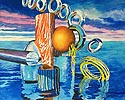
H ere's cleaning advice for acrylic paintings and artwork
not under glass.
Every once in a while take a clean damp cloth (like an old cotton tee shirt) and gently wipe the
surface of an acrylic painting off to remove grime that has accumulated. This is only for artwork that is not under
glass. First gently try an inconspicuous corner before progressing to be safe. Watch out for areas that are raised
with little mounds of paint. Be careful that you don't catch them with your cloth and rip them off.
Click here to discover the source of creativity.

Take into account the temperature and humidity of your home.
It's important to keep the climate of your home stable with the temperature about 70
degrees. Humidity should be about 50%. High humidity can cause works on paper to be destroyed by mildew. Once I
lived in Papua New Guinea for fifteen months as a short term assistant with the Summer Institute of Linguistics -
Wycliffe Bible Translators. It was so humid there that orchids grew right out of wooden fences. Cameras could not
be stored with their lens caps on or mold would grow right on the lens.
Consider using safe wall hang-ups when displaying your collection. Paintings should
hang farther out from the wall on the top and be closer at the bottom. Use sticky pads for paintings on the backs
of your art on the bottom to push them out a little from the wall. The painting needs room so that air can
circulate behind it. Be sure your wires and hanging hardware are in good condition so that the painting won't come
crashing to the floor when you least expect it.
 Protect your investment on moving day. Protect your investment on moving day.
When carrying your treasured pieces - don't grab them by the frames - but provide
support from opposite sides. Protect works that aren't under glass with pieces of cardboard and blankets or box
them. Put your glass-covered artwork in protective boxes and keep them as cool as possible. Don't let the sun beat
down on your paintings. If works framed under glass get very cold, when the sun shines on them they'll probably
sweat. Condensation will occur under the glass right next to the painting. If this happens, don't panic, the
condensation will disappear after awhile. This happened to my work more than once when I showed framed watercolor
pieces in outdoor shows.
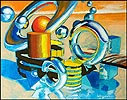 Read this if you frame your watercolor painting yourself. Read this if you frame your watercolor painting yourself.
If you purchase a watercolor painting and decide to save money by framing it
yourself, here's a warning. Don't let your painting touch the glass. Your artwork will mold in time. Make
sure there are protective mats keeping the painting from touching the glass. And don't buy the cheapest possible
mats. If they aren't acid-free, they will turn the edges of the art work yellow after several years or less. Also,
be sure to use acid-free tape when you tape your painting down on a backing board or it will turn your artwork
brown.
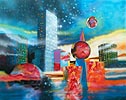 Are you running out of room to hang art? Are you running out of room to hang art?
If you love original artwork, but feel that you have no room for any more pieces,
why not think about your home as a gallery with rotating exhibits. Find a safe place to store the pieces you
aren't displaying at the moment and then bring them out later. You might like to consider doing this with
seasonal subjects. For example, you could hang a spring painting in spring - or a fall subject in autumn. And later
on, hang a winter scene in winter. Sometimes we can get into a rut and our interiors can always look the same with
no change. By having a rotating gallery of our very own, we can bring wonderful new looks into our homes whenever
we wish.
 Protect your walls this way. Protect your walls this way.
Be sure to attach wall protectors to the backs of all the artwork you hang on your
walls. They are small round disks that stick to the bottom corners of your piece.
If you forget to do this, in time the painting will permanently darken the wall
behind it and ruin your paint job.
 Here's why you might want to choose acrylic art. Here's why you might want to choose acrylic art.
Never hang artwork in direct sunlight. The sun will fade your art. A bonus in favor
of acrylic paint - It's probably the most durable of all paints.
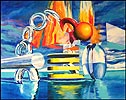 Be careful what materials you use in framing your art. Be careful what materials you use in framing your art.
The most important piece of advice I can give you is to make sure that the materials
you choose to frame your painting will not hurt it. Of course, that would decrease the value of your artwork as
well as your pleasure in viewing it.
Don't hang works of art near sources of heat - such as near radiators. Don't hang
your paintings on outside walls that get colder than other walls in your home. IF you hang artwork over fireplaces,
keep a close watch to make sure it isn't getting damaged by smoke and heat. Also watch for insects. Since kitchens
and bathrooms get steamy and greasy, they're usually not good places to hang your collection.
When you go on vacation for several weeks, try to get someone to come to your home
and air it out from time to time to prevent dampness.
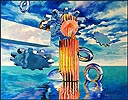 The sun is your art collection's worst enemy. The sun is your art collection's worst enemy.
Whereas the sun turns us darker, it actually leeches the pigment from paper or
canvas. Make sure your lamps have shades on them and aren't shining directly on your art. It's best for your
paintings if they are rotated on a regular basis to give them periodic protection from light exposure.
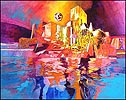 Leave painting repair to a professional restorer. Leave painting repair to a professional restorer.
However, if it is torn, you can and should put a piece of masking tape behind the
torn spot as a temporary measure. Smooth out the edges on the back of the work as best you can. If you don't tape
it as soon as possible, the canvas could curl back and damage the paint on it.
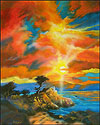 Remember this when storing your art. Remember this when storing your art.
If you need to put your painting in storage, only place it in a cool, dry area. It
should be stored in an upright position.
Don't forget to occasionally check for signs of insect damage and mildew.
| 



 Protect your investment on moving day.
Protect your investment on moving day. Read this if you frame your watercolor painting yourself.
Read this if you frame your watercolor painting yourself. Are you running out of room to hang art?
Are you running out of room to hang art? Protect your walls this way.
Protect your walls this way. Here's why you might want to choose acrylic art.
Here's why you might want to choose acrylic art. Be careful what materials you use in framing your art.
Be careful what materials you use in framing your art. The sun is your art collection's worst enemy.
The sun is your art collection's worst enemy. Leave painting repair to a professional restorer.
Leave painting repair to a professional restorer. Remember this when storing your art.
Remember this when storing your art.